
BoG maintains policy rate at 16%
For the fourth time this year, the Monetary Policy Committee of the Bank of Ghana (BoG) has maintained the policy rate at 16 per cent.
The decision to maintain the rate was as a result of some threats to both inflation outlook and economic growth.
Advertisement
This was announced by the Governor of the Bank of Ghana (BoG), Dr Ernest Addison, while addressing the media after the 91st Monetary Policy Committee (MPC) meeting in Accra.
He added that the threats to inflation were broadly balanced hence the need to maintain the policy rate at 16 per cent.
He said the committee noted the synchronized growth slowdown across advanced economies and its potential spillover effects on emerging markets and developing countries.
“In addition to subdued inflation, recent assessments indicate that the global economy is in a low growth, low interest rate environment. Major central banks have, therefore, shifted towards accommodative monetary policy stance which will likely persist until signs of growth emergence or inflation pick-up becomes evident.
“These developments have triggered favourable global financing conditions as investors search for yield in emerging markets and frontier economies with strong fundamentals, underscoring the need to further consolidate the macroeconomic gains and to position the economy to benefit from the favourable external financing conditions,” he stated.
Inflation
Mr Addison noted that the three readings of inflation since the release of the rebased Consumer Price Index by the Ghana Statistical Service showed that inflation had remained below its central path of eight per cent.
He said headline inflation declined from 7.8 per cent in August 2019 to 7.6 per cent in September, and had since inched up to 7.7 per cent in October on the back of the recent upward adjustment in administrative prices of electricity and water.
Looking ahead, he said, inflation was projected to stay within the medium-term target of 8±2 per cent over the forecast horizon.
Commodities
On the international commodities market, Dr Addison said data showed that crude oil prices fell by 3.8 per cent on a year-to-date basis to close at an average of US$59.8 per barrel for October 2019.
He said the decline was on account of investor concerns about the unrelenting US-China trade tensions and continued build-up in US crude inventories.
He noted that gold prices also slipped marginally to $1,490.9 per fine ounce after trading above the $1,500 per ounce for two successive months on the back of dovish monetary policy stance by major central banks.
“On a year-to-date basis, gold prices gained 18.9 per cent. The average price of cocoa increased by 11.2 per cent to settle at $2,475 per tonne in October 2019. This was mainly supported by increased third quarter grinding data which serves as proxy for demand,” he stated.
Trade account
He said the favourable commodity price developments, together with increased production volumes, impacted positively on the trade account.
In the period January to September 2019, exports stood at $11.7 billion while imports started recovering, reaching $10.0 billion.
These developments resulted in a further improvement in the trade surplus which stood at $1.68 billion, compared with $1.56 billion in the same period in 2018.
Current transfers improved, resulting in a further lowering of the current account deficit to $829.5 million, compared to a deficit of $1.0 billion in the same period of 2018.
Gross International Reserves (GIR) increased by $1.67 billion to$8.70 billion as of November 15, 2019, providing cover for 4.2 months of imports. This compares with the end-December 2018 position of US$7.02 billion which is equivalent to 3.6 months of import cover.





